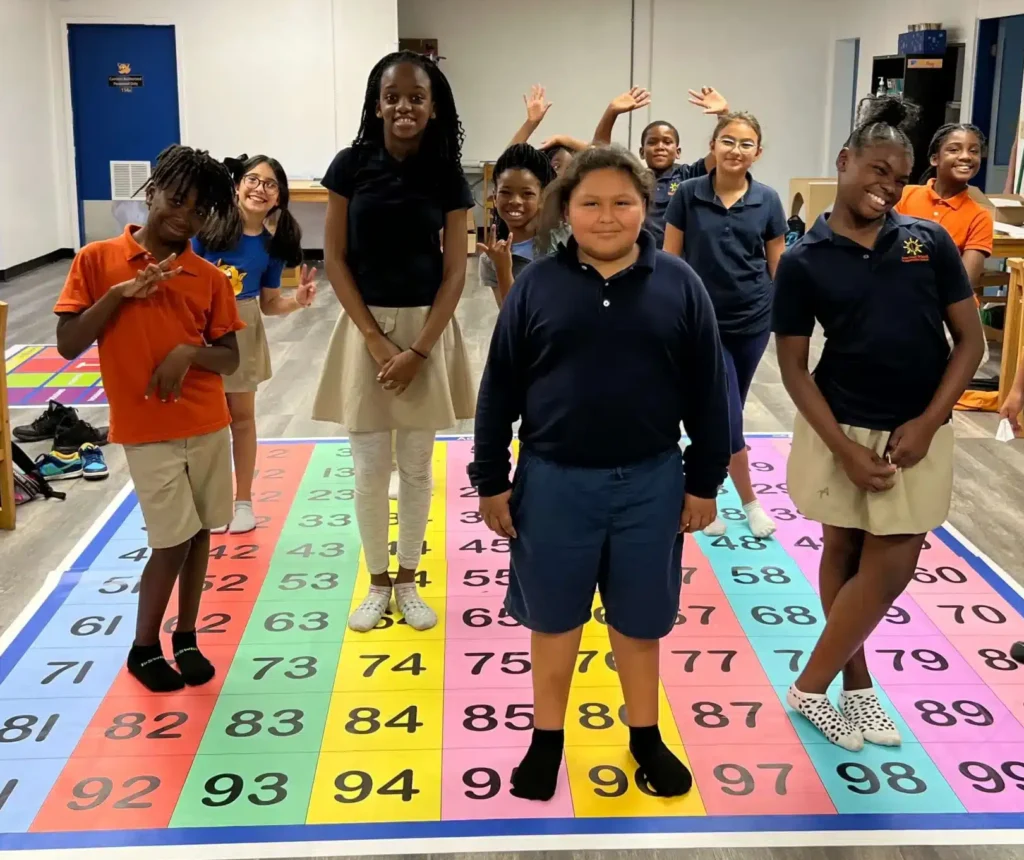Kinesthetic Learning Boosts Multiplication Skills in Sarasota

-
Suncoast School for Innovative Studies
Public Charter School
Sarasota County School District
Sarasota, FL
-
Third Grade
Classroom Study
-
Pre and Post-Tests
Program Evaluation Tools
-
10 Days, 2-3 hours per day
Program Timeline
Study Focus: Kinesthetic teaching methods for multiplication
The focus of this study was to evaluate the impact of kinesthetic teaching on students’ multiplication skills. We found that, as a result of using the floor mats, students learned their multiplication facts 4 times faster* than through traditional methods and showed significant improvement in their understanding of multiplication.
Our findings highlight a critical insight: Students typically spend an average of 10 weeks during the school year learning multiplication tables, yet the outcomes often fall short of expectations. This became evident in our study, conducted at the end of the academic year, when many students still struggled to grasp multiplication despite months of instruction.
Remarkably, within just 10 days of implementing our program, these same students achieved significantly greater progress than they had throughout the entire year. Before starting the program, the average proficiency for multiplication by 4s (the first multiple we worked on) was only 26%, even after a year of traditional instruction. This stark contrast underscores the program’s transformative impact on learning efficiency and retention.
Over the course of 10 days, students learned and practiced multiplication by 4s, 6s, 7s, 8s, and 9s. Notably, students improved their understanding of multiplication by 7s, which they typically find challenging, with an increase of 118%.
*Four times faster than a typical 10-week-long multiplication unit.
Challenges
-
Study was conducted at the end of the school year. Students often experience "summer fever" as the school year comes to a close, which can affect their focus and motivation.
-
Multiplication is a crucial unit for third graders, heavily emphasized in state tests. At the beginning of the study, students were scoring at an average of only 26%, raising significant concerns.
Solution
-
Jump & Learn Multiplication - a multiplication workbook with positive affirmation stickers
-
Professional Development for classroom teacher
Results
-
On average, students’ post-test scores on fours were nearly three times higher than their pre-test scores.
-
The largest improvement for a single multiple was in multiplication by 4s, with students averaging a remarkable 202% increase—this was the first multiple they learned using the new approach.
-
Students made an impressive 118% improvement in their pre- and post-test scores for multiplication by 7s, a particularly challenging multiple.
-
There was an average improvement of over 89% among students across all multiples.
-
Students learned multiplication facts 4 times faster than traditional methods.
-
The performance gap between students narrowed by over 81%, dropping from a difference of 53 points to just 10 points.
-
Attendance improved as students were eager not to miss class, each working towards milestone goals set in the program.
-
Student behavior also showed positive changes; teachers noted increased focus on workbooks instead of talking with peers.
-
Instances of bullying decreased, as students’ self-efficacy and confidence grew, allowing them to work independently and use mats to find answers.
Reflections from the Teacher
The numbers tell an impressive story, but the true power of this program lies in the day-to-day classroom transformations it inspired. From newfound confidence in tackling tough multiplication problems to a noticeable shift in focus and engagement, these changes were felt by the students and seen by their teacher every step of the way.
In his own words, hear how this kinesthetic approach reshaped the learning experience and fostered a deeper connection to math.
“Bridging the gap has created so much more harmony in my classroom and it’s fun to watch!”
Malcom Mills, Third Grade Teacher
Hear from Mr. Mills:
Reflections from the Principal
The success of this program extended beyond the classroom, catching the attention of school leadership. The principal witnessed firsthand how kinesthetic learning transformed student outcomes and revitalized the energy within the school. From improved test scores to students excited to participate, the program demonstrated its potential to reshape traditional math instruction.
Hear directly from the principal about the profound impact this approach had on the students, teachers, and school community:
"Before Math & Movement, our kids were really struggling with the concept of having to do math…Our kids felt like math was scary…Now, I don’t even know if they realize they’re doing math...They absolutely have a different viewpoint. They feel like it is something they can learn."
Fayth Jenkins, Principal
